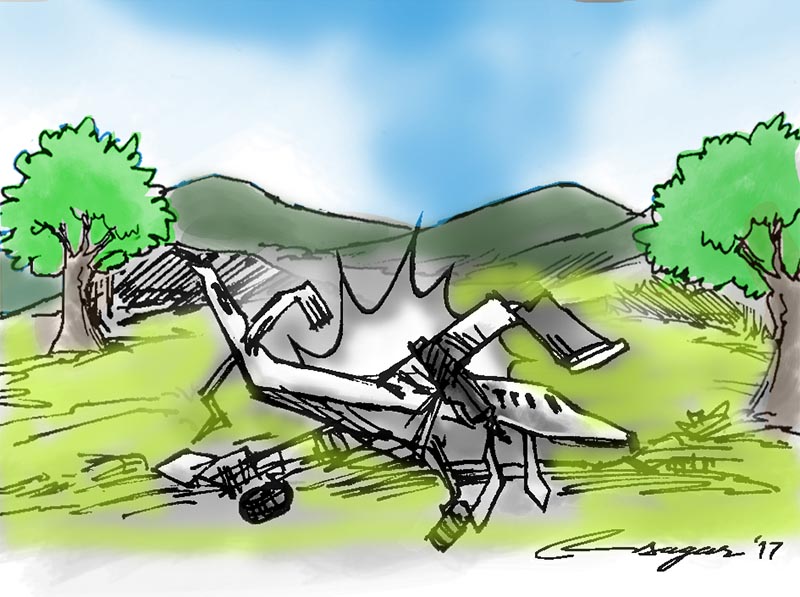Behind plane crashes: Cultural aspect
The investigation report will dig through the series of events that led to the accident. It will point out the ‘Human Factor’ as the main reason. We had the same report for the Tara Air crash. But those reports don’t get into the mind of pilots, those reports do not look at airline management, and the reports do not take a leaf from Gladwell
On May 27th, we lost Goma Air Let 410, on May 30th 2017 we lost a Nepal army Skytruck, on February 24 we lost Tara Air Twin Otter and on February 26th 2016 we lost Air Kasthamandap, PAC 750XL and many lives were lost in these accidents, and thousands of dreams were shattered.
These accidents happened at a time when the industry is still on a limp to try to tell the world that Nepali airline companies are safe. Among the brave pilots that we have lost in those accidents I remember Captain Paras who as a pilot had an excellent safety record. Captain Colonel Kailash Gurung was known to be assertive and experienced Captain Dinesh lost his life while he succeeded in saving his passengers. Captain Roshan Manandhar was one of the best with more than 20,000 hours of flight experience, I had known him since 2012 during my simulator training.
While shedding tears for the departed, I recalled Malcolm Gladwell’s famous book, Outliers: the story of success, in which the author talks of crashes involving experienced captains and of the relatively inexperienced first officer and a brand new aircraft with the best equipment similar to the recent air crashes in Nepal.
He points out how Korean Aviation suffered due to high power distance index (PDI) in the cockpit. I believe that to some extent, this might very well be the reason for air accidents in Nepal.
Power Distance is the psychological state where there is difference in figures of authority. High power distance index means you will believe everyone has a specific place in hierarchy of power. You will expect the power to be divided unequally, just like in cultures like in Nepal. It’s not our culture to question a superior authority. This particular tradition is seen in offices, families, schools, and security agencies and in every layer of our society.
After every air crash, an inquiry committee is formed that reports on the cause and provides recommendations. But so far, no one has particularly tried to dig into the cultural aspect of air crashes in Nepal.
The reality is that in the Nepali aviation industry, which happens to conform with Nepali cultural values, a first officer, no matter his/her experience, is seldom listened to. Let’s face it: in Nepal, once inside the cockpit, the first officers are not empowered to question the decisions they are not comfortable with.
Whenever there is an air crash in Nepal, we follow a cycle. First we get sad for losing our loved ones. Then we are angry and blame others. Then we accept the fact as fate and finally forget the whole thing.
And after a few months, the same thing repeats. Isn’t this a similar feeling that we went through during the Sita Air crash on the Manaharain Kathmandu or the Buddha Air crash in Lalitpur ? We have almost forgotten the Tara Air Myagdi crash and yet again we lost Goma Air and Nepali Army aircraft and our friends.
It is imperative to break this chain. When we are sad, we are supposed to promise ourselves that we will never let this happen again, either by investing millions in our infrastructures, equipment, training or implementation of rules.
When we are angry, we are supposed to react by pressing the authorities to do their part, just like the American people did after the Buffalo, NY crash of Dash 8 Q400. We need to turn our anger into strength.
We are not supposed to accept that plane crashes are the results of fate, there is an absolutely zero act of the divine for plane crashes, there is always something tangible and measurable. We are never supposed to forget the accidents and our future generation should be confident that we did our part to save their lives.
When accidents like these tend to topple the whole system and the whole industry, we have to realize that we are in desperate times, and this demands desperate measures. We try to find a reason for every crash. We talk about bad weather and human error, and leave out important issues like power relations inside the cockpit.
We know using Visual Flight Rules (VFR) flight for Instrument Meteorology Conditions (IMC) is not allowed; yet pilots do it, on a regular basis. We need to ask the major question. Why do they do it? Not who did it?
The very first question after a crash is, who was the pilot? Which airlines was it? Where did it crash? But nobody asks why did it crash.
The EU did their part in nudging us by blacklisting. This has hurt our industry, and this industry is backbone of our economy and we can’t afford to have more air crashes.
The aircraft that crashed in Lukla that day was a brand new aircraft and highly sophisticated in terms of equipment available to the pilots. Yet that plane crashed.
The investigation report will dig through the series of events that led to the accident. And will point out the ‘Human Factor’ as the main reason. We had the same report for the Tara Air crash. But those reports don’t get into the mind of pilots, those reports do not look at airline management, and the reports do not take a leaf from Gladwell.
Bhandari is First Officer with the Himalaya Airlines Pvt. Ltd






